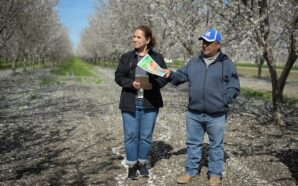NAPS
Although childhood obesity rates have leveled off, obesity rates for teens have doubled in recent years—but you can protect them. Today, one in every five teens ages 12 to 19 is obese. Obesity in the early stages of life is more likely to follow into adulthood. But it also has an immediate impact. Obese teens may miss out on fun activities, face more health issues, suffer from a lack of confidence and self-esteem, and may even miss out on opportunities to get a job.
What’s a parent to do? Helping your teen eat more fruits and vegetables on a regular basis can improve health and build healthy habits for life. “Fruits and Veggies —More Matters®” month in September—or anytime of year—is a great time to show your teen how to eat healthy by eating more fruits and vegetables.
“Many teens don’t realize that their eating habits are affecting the way they look and feel today,” said Elaine Auld, chief executive officer of the Society for Public Health Education (SOPHE). “Point out the effects of the food selections they control and the benefits of healthy eating—better skin and hair, more energy, improved sleep, and weight management.” Auld offered a few more tips:
Talk with your teen. Discuss how food selections affect how they look and feel today. Find out the barriers to eating a more healthy diet with fruits and vegetables. What fruits and vegetables are your teens’ favorites? Could you help them try some new ones?
Get a baseline. Have your teens write down what they have eaten for several days using the notepad on their phones. Then, review the list and have your teens identify one or two small steps for improvement.
Share online tools. Your teens can use free online tools that show the nutritional value of foods before they order. Talk with your teens about their daily schedules and meal plans. Discuss how your teen could eat a healthier diet with more fruits and vegetables. At each meal, about half of your plate should be fruits and vegetables.
Make it easy. Check how many fruits and vegetables you have readily on hand and if you need to change your shopping habits. Find a farmer’s market nearby. Keep fresh fruit out in a bowl on your table. Cut up vegetables and keep them in your fridge in ready-to-eat portions.
Mix it in. Add fresh, frozen or canned vegetables to salads, side dishes, pasta sauces, omelets, pizzas or other dishes. If using canned vegetables, select those labeled “reduced sodium,” “low sodium” or “no salt added.”
Involve your teen in meal planning and grocery shopping. Research healthy recipes online together. Ask your teen to help you plan family meals for a week. Bring your teen with you to the grocery store. Ask your teen to select fruit and produce and be open to new and different choices.
Invite your teen to help you in the kitchen. Include your teens in meal preparations. Ask them to cut vegetables or fruits for a meal or for quick “grab and go” packets for the entire family. Try to take a favorite family recipe and make it healthier together. Teens love to experiment.
Point out healthier options when eating out. Talk about the healthier options on restaurant menus and choose one for yourself.
Set a good example. Be a role model in what you choose to eat. Try to frame your family culture around healthy eating. Offer fruit and vegetable options with every meal.
What Communities Are Doing to Promote Healthy Eating for Teens
Just as people plan healthy nutrition into their routines, so do communities. SOPHE is part of a national program to prevent chronic diseases like diabetes and heart disease, funded by the Centers for Disease Control and Prevention.
SOPHE is working alongside four organizations with a network in 100 communities across 37 states. The other partners include the American Heart Association (AHA), the American Planning Association (APA), the Directors of Health Promotion and Education (DHPE) and the National WIC Association (NWICA).
Middle schoolers involved with Oregon Kids Move with Heart are doing brain boosts in health classes, thanks to a toolkit provided by the AHA. At Douglas MacArthur High School in San Antonio, students have started a new garden and are composting fruit and vegetable trimmings from the cafeteria. Their efforts are aided by a new toolkit on creating sustainable school gardens.
In Columbus, Indiana, community organizers with the APA are working to make streets safer for pedestrians and bicyclists. In Indianapolis, community leaders are trying to make the community more walkable for everyone by instituting a comprehensive plan.
Many teens and their families do not have access to healthy food. In rural Galax, Virginia, the H.A.N.D.S. Healthy Corner Store initiative with NWICA has increased availability of fresh produce and healthy snack options in rural convenience stores, worked with Farmer’s Market Managers to increase public awareness of fresh, locally grown produce, and done cooking demonstrations.
Communities can take more steps to show healthy eating for teens and their families. “Talking with your teen about eating fruits and vegetables is important,” said Auld. “We want to make healthy living easier. Helping teens establish good habits now sets them on a path toward success and health later in life.”
Learn more about the national project to prevent chronic disease at <www.partnering4health.org> and get more information for your teen at <www.choosemyplate.gov/teens>.






